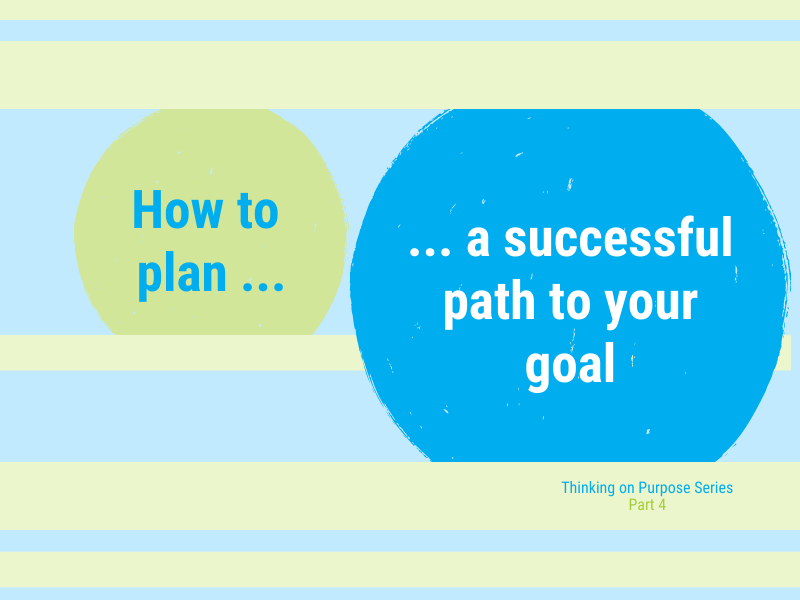If we set ourselves a goal – a certain outcome we want to achieve, a change we want to make, a habit we want to create – we need an action plan.
We need to know the steps it takes to get us from here to where we want to be.
Very often our mind tries to make action planning difficult.
We come up with the idea for a goal and we are all in, and then our mind gets nervous and says, ‘Wait a sec. You think you can do this? Are you kidding? There is no way you can achieve this. Just drop the idea and save yourself the disappointment.’
This is a normal and natural reaction of our mind.
It’s its job to keep us safe and out of danger. Our mind wants to avoid any risks, that’s why it doesn’t like change and wants to keep things as they are.
It is important to listen to our mind.
We need to become aware of the thoughts that come up with regard to our goal: All thoughts – the supportive ones and also the ones that try to talk us out of pursuing our desired goals.
So, yes, we need to listen to our mind but we always should remind ourselves that we don’t need to follow its recommendations.
We don’t have to do what our mind wants us to do (or not to do).
Our thoughts are just sentences in our mind and they are optional. We can always decide what we want to think.
We don’t have to believe our mind’s objections, instead we can use them to help us define the steps we need to take to achieve our goal.
As soon as we notice all the fearful, pessimistic, critical, judgemental, and other negative thoughts, we can decide to see them not as obstacles on the way to our goal but as helpful signposts that can guide us.
We take a closer look at all the objections our mind offers, and we develop a strategy how to overcome each of them. These strategies then become the main elements of our goal-achievement action plan.
EXAMPLE:
Goal: I want to lose 4 pounds during this month.
The task is to find the obstacles thoughts and to use them to develop an obstacle-overcoming thought. This is the new thought that needs to be practiced.
Some examples:
Obstacle-Thought Number 1 – ‘Losing weight is hard and frustrating and I tend to quit when things become frustrating.’
-
- Obstacle-overcoming Thought Number 1 – ‘I expect and accept feelings of frustration to come up. They are part of the process and not a big issue. I am going to be frustrated, yes, and that’s o.k. (It’s better than being frustrated because I weigh too much!)’
Obstacle-Thought Number 2 – ‘I tried to lose weight in the past and it never worked out.’
-
- Obstacle-overcoming Thought Number 2 – ‘The past is irrelevant, it has nothing to do with what I am capable of achieving in the future. I plan to focus on the visualisation of my future self, the person who knows how to lose weight and always sticks to her plans.’
Obstacle-Thought Number 3 – ‘I am afraid that I will not stick to the eating plan and that I will feel like a hopeless looser if I fail.’
-
- Obstacle-overcoming Thought Number 3 – ‘Of course I will fail, failure is part of the path to success. That’s no problem. I’ll learn from each failure and move on with new energy.’
As we can see in this example, the action plan consists of a list of supportive and powerful thoughts that help us take action whenever our mind comes up with its obstacle-thoughts.
The toolbox of helpful obstacle-overcoming thoughts will look different for each of us, even if we pursue the same goal.
We are all unique personalities and our minds are very unique as well. And so are our obstacle thoughts and our strategies to overcome them.
We have to invest some time to listen carefully to our mind, so that we can see our very own obstacle-thoughts.
Then we get well prepared with the help of a well-designed obstacle-overcoming action plan:
We assign at least one strong supportive thought to each obstacle-thought, so that we are well equipped when our mind comes up with objections (and it will!) while we are moving towards our goal.
Now it’s your turn!
-
- Choose a goal you want to achieve.
- Then list all the obstacle-thoughts that your mind will probably immediately offer to you. Don’t push them away, don’t judge them, just take a closer look.
- Now get creative and start to compile your toolbox of obstacle-overcoming thoughts.
- And then make sure that you have these supportive thoughts always close by. Study and memorise them every day – so that your mind can get used to them and begins to accept them as your new truth.
You will soon notice that the old obstacle-thoughts lose their power and how your new thoughts help you move forward towards your goal.
HOW CAN I HELP YOU?
Are you tired?
Tired of trying to (re)organise the various areas of your life entirely on your own?
Fortunately, you don’t have to figure it out all by yourself.
We can do it together.
You can decide to get my support, advice, and guidance – and achieve the desired changes in your life so much faster and easier.

